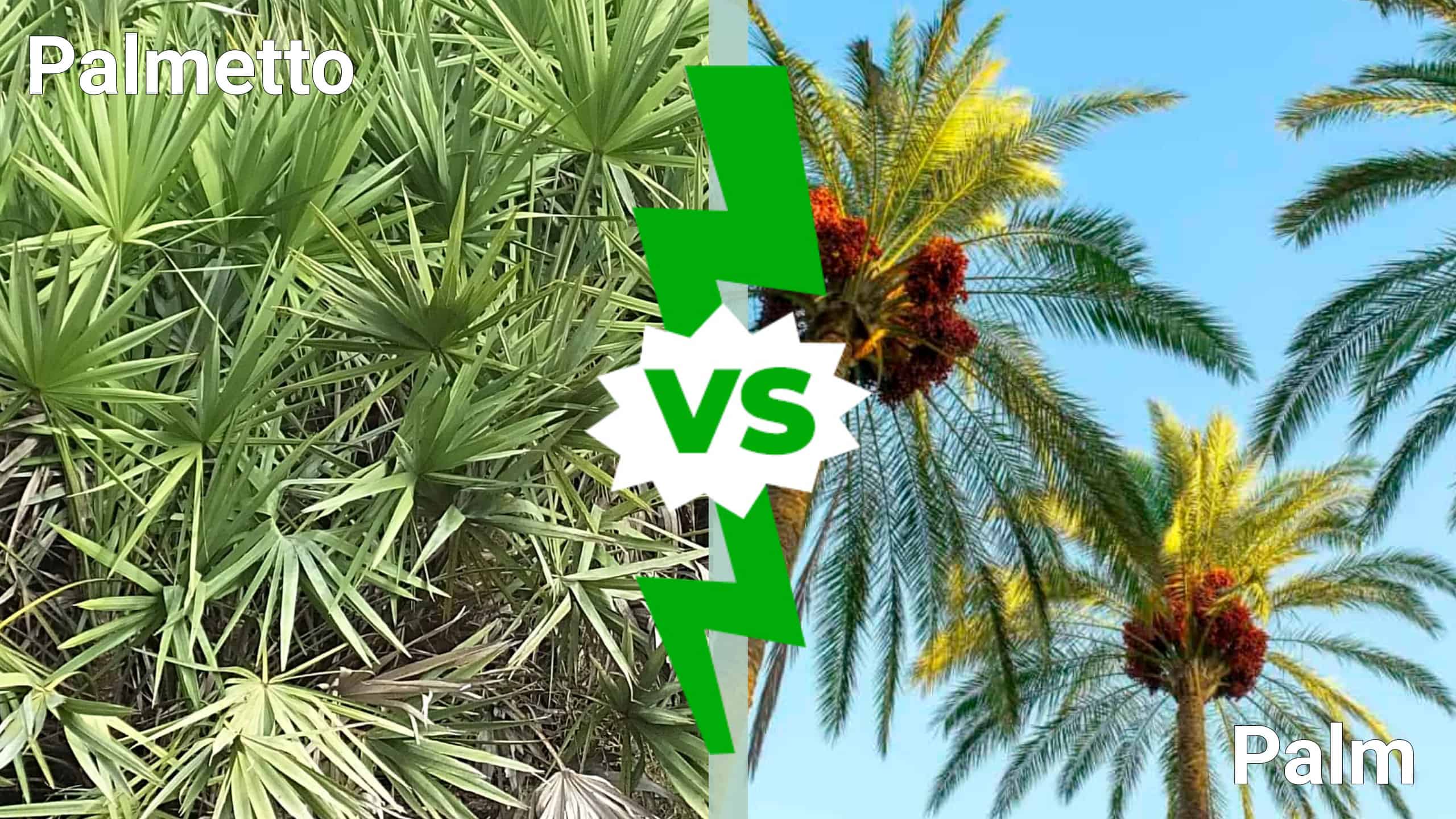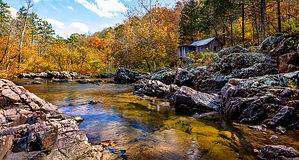Palm and palmetto sound very similar, but are they the same thing? This article will discover palmetto trees vs. palm trees and compare these iconic trees of the south and the tropics. We’ll uncover native ranges, foliage, flowers, height, and their use throughout history.
Let’s dive in.
| Attribute | Palmetto | Palm |
|---|---|---|
| Height | Up to 30 feet | Up to 80 feet |
| Trunk growth | Horizontal growth | Vertical growth |
| Leaf shape | Fan shaped leaves | Feather shaped |
| Flowers | Urinary tract medicine, wildlife shelter, fire-resistant planting | Feathery fragrant blooms |
| Fruits | Small black berries | Large dates or coconuts |
| Native range | South Carolina and Florida | Tropical regions: Africa, South America, Middle East |
| Uses | Wine, oil, roofing, coconut, and date production. | Wine, oil, roofing, coconut and date production. |
Are Palmetto Trees and Palm Trees the Same Thing?
No, palmetto and palm are two different trees with noticeable appearance and use differences. A palmetto is not a palm. However, they belong to the same Arecaceae family and grow in similar habitats.
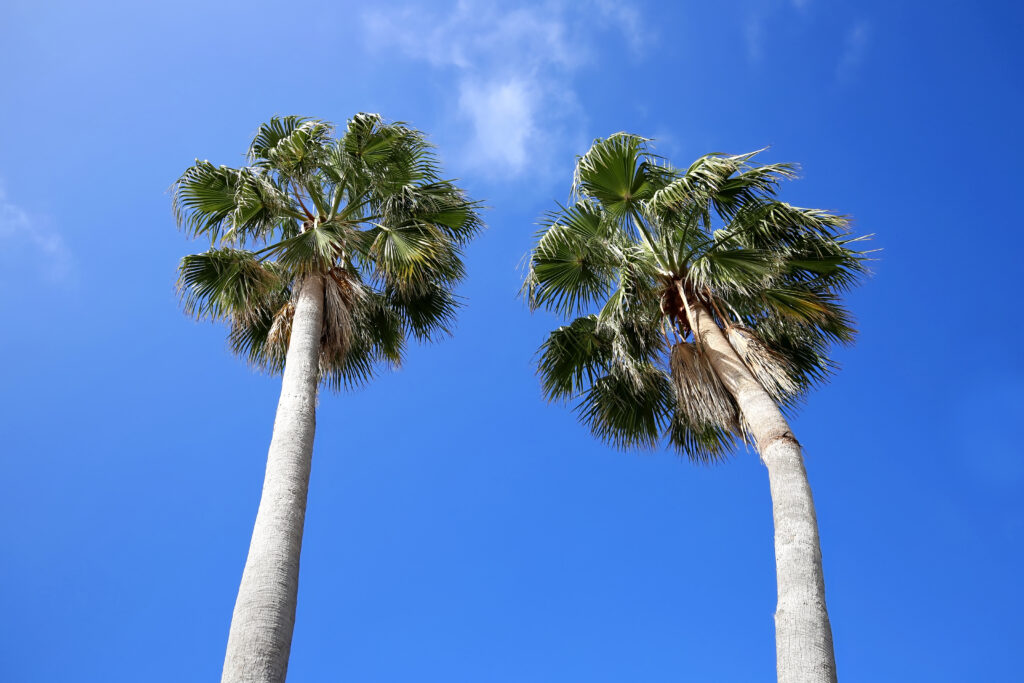
Palms and palmetto trees belong to the same
Arecaceaefamily.
©Jillian Cain Photography/Shutterstock.com
Identification Tips
First up, let’s look at how their appearances differ.
Palmetto Tree vs. Palm Tree: Appearance
Height
Some palmetto trees grow low to the ground and grow just a few feet tall, whereas others reach a maximum of 30 feet tall. In comparison, palm trees grow taller. They get 80-plus feet. This is probably the most obvious difference between the two.
So how can you tell the difference between a palmetto and a young, short palm? Let’s continue!
Trunk
Palm tree trunks grow vertically, towering in the skyline, whereas palmetto trunks grow horizontally. Their main stem grows underground and throws up stems that grow vertically. Neither has bark like a pine or oak tree.
Foliage
Evergreen palmetto leaves fan out and grow much wider than palm leaves. They cluster at the base and spread out like an outstretched hand up 30 inches long. Each leaf has small serrations; hence the common name “saw” palmetto. Palmetto trees grow beneath larger trees in their native environment, so their leaves grow larger to catch filtered sunshine.
Palm leaves, however, dominate the skyline. They don’t need such wide leaves to catch sunlight because they grab it first. Their thin foliage is feather shaped. It forms in a spiral or alternate pattern and reaches approximately 36 inches in length, depending on the species. They grow horizontally from a stalk at the tip of the tree in large fronds.
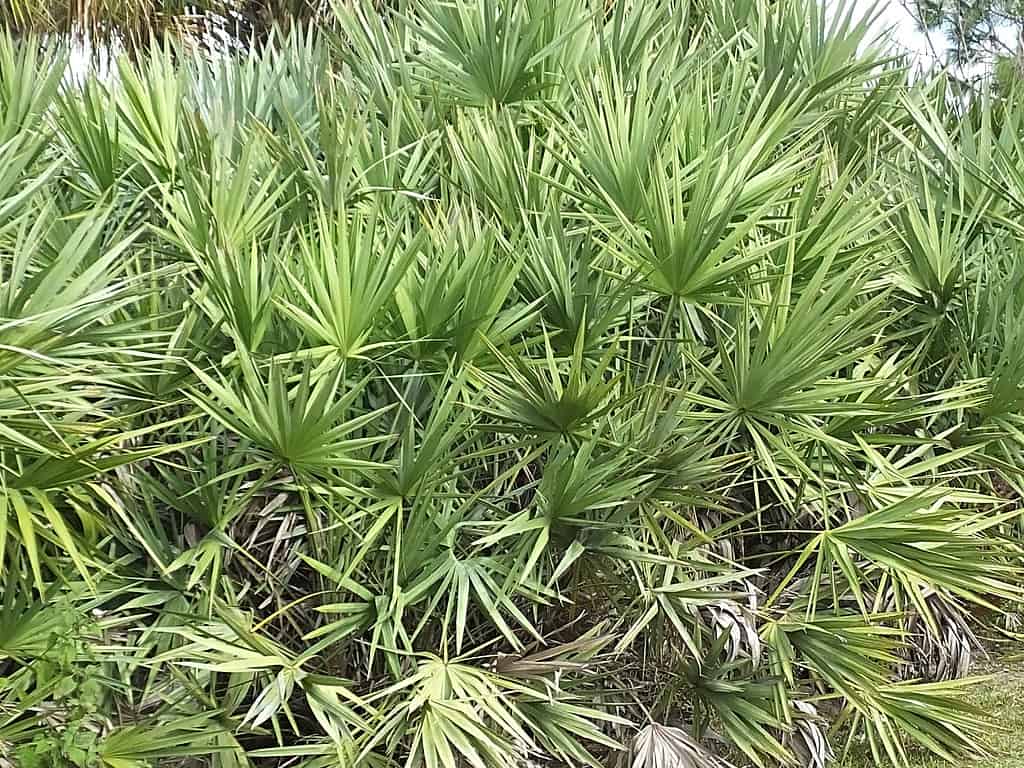
Saw palmetto grows beneath larger trees, so it has wider foliage to catch filtered light.
©iStock.com/passion4nature
Flowers
Lance-like, stiff palmetto flowers appear as long or short sticks of yellow that emerge from palmetto and dwarf palmetto trees. Usually, quite drab, palmetto flowers range from scrub palmetto’s tiny white flowers to saw palmetto’s sweetly scented yellow blooms on three feet long stems.
Palm trees produce plumes of soft, white, feathery flowers. Queen palms and desert palms’ flowers are most showy with fragrant fluffy white blooms. Insects and birds love the flowers. Birds take the soft parts to line their nests.
Fruit
Palmetto trees produce small berries up to one inch long that birds and mammals love. The inconspicuous flowers mature into dense clusters of fleshy fruits that ripen to black.
In contrast, palm trees produce tasty dates or coconuts. Queen palm produces bright orange dates, whereas the coconut palm grows coconuts so hard they can injure people.

Coconut palm trees produce such large coconut fruits that they cause injuries when they fall.
©Thasneem/Shutterstock.com
Native Range
The palmetto tree is native to South Carolina whereas palm trees are native to tropical and sub-tropical regions such as Africa, the Caribbean, southern Asia, and South America. Experts believe palm trees first grew in Africa millions of years ago. One of the oldest palm tree fossils is 60 million years old!
Both palm and palmetto trees have been transported worldwide, where they grow in warm climates.
Historical and Cultural Significance
Palmetto is Florida and South Carolina’s state tree, where it’s called cabbage palm, swamp cabbage, or blue palmetto. Native Americans, including the Miccosukee, used its berries medicinally to treat urinary tract problems, and when Europeans arrived, they recognized the benefits too.
Palmetto trees were celebrated during the Revolutionary War, specifically when the British were unable to assault Fort Moultrie in Charleston in 1776 because a thick wall of palmetto held them at bay. Thus, they symbolize resilience and endurance in the southern states.
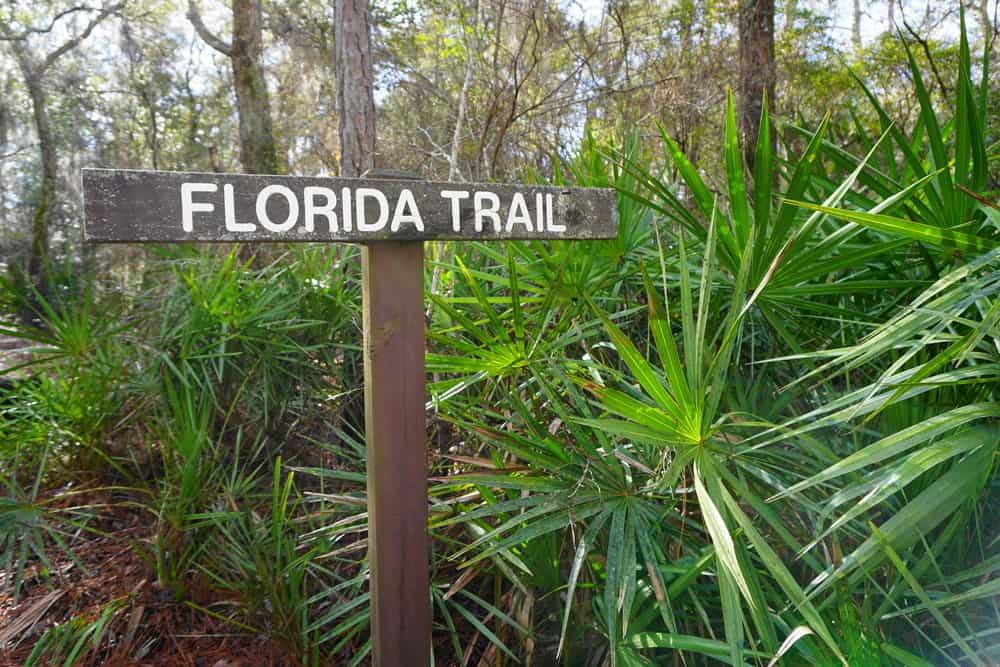
Palmetto is South Carolina and Florida’s state tree.
©Shannon Carnevale/Shutterstock.com
Palm trees have wide-ranging historical and cultural significance. They symbolize peace and triumph in the Mediterranean; for example, victorious ancient Greek athletes were given a palm frond. Palm fronds represented immortality in ancient Egypt and personified Victory in ancient Rome.
Palms are frequently seen in the Christian religion, for example, on Palm Sunday, where Jesus was said to enter the gates of Jerusalem triumphantly. Judaism also uses palm fronds in significant religious festivals.
Climate and Soil Requirements
Both palmetto and palm trees require warm climates, but cold hardy cultivars bred by botanists are available for cool-area palm family lovers.
Tropical palms struggle to grow in temperate zones under 16 degrees, but they can cope with high winds, even hurricane force. Hardier palmetto trees cope with less heat, but not much. They still need humid tropical and sub-tropical temperatures to thrive. They do best in North America’s South.
In terms of soil, palmettos can cope with fresh and salt water. Natively, they grow in salt flats, cactus thickets, wet prairies, freshwater cypress swamps, and barrier islands. They tolerate chalky soils, often growing near limestone outcrops.
Palm trees are fussier. Sandy, well-draining loam is best, so their roots can spread without too much resistance. Date and coconut palms tolerate salt, but others suit humid rainforest conditions.
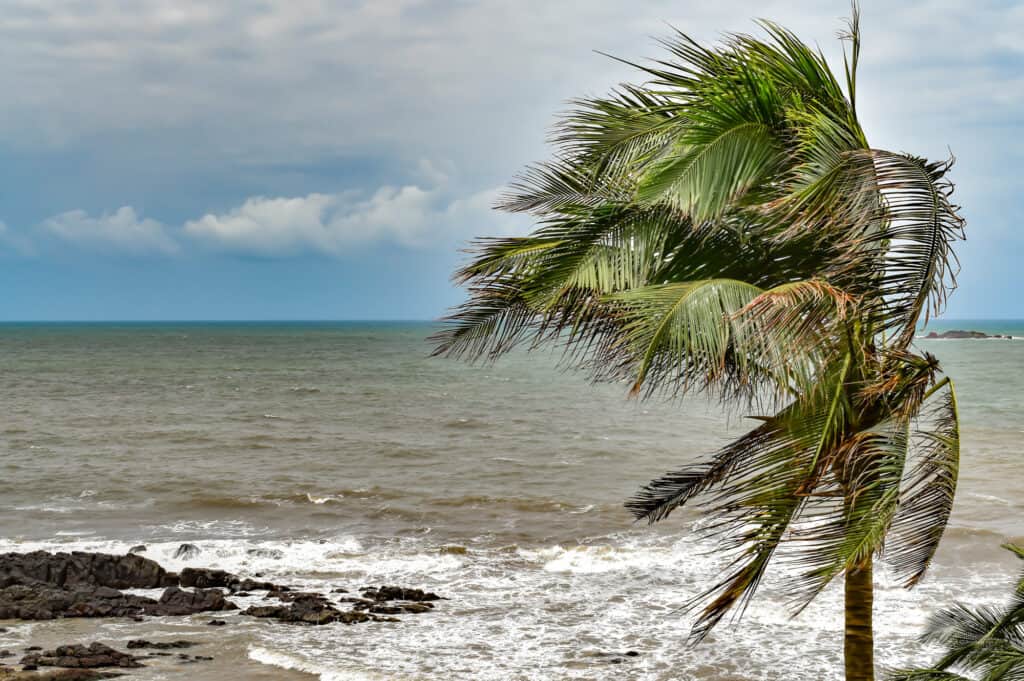
Palm trees can withstand hurricane-force winds.
©iStock.com/Ashish Kumar
Popular Uses
Used by Native Americans for their medicinal benefits, palmetto tree berries may improve urinary health. Modern research indicates this may well be the case. In fact, palmetto may support prostate issues too.
Palmetto foliage is eaten and used for fuel in some areas of the world, and certain wild animals, like feral pigs, black bears, and opossums, eat the berries and foliage. However, it’s birds that play the biggest role in seed dispersal.
Several animal species actively use palmetto for nesting and protection. Florida’s endangered grasshopper sparrow builds its nest in saw palmetto, and rodents such as the Florida woodrat use palmetto’s horizontal root structure to build sturdy, waterproofed dens. White tailed-deer, wild turkey, and numerous bird species hide and sleep in its foliage through the seasons.

Endangered grasshopper sparrows use palmetto foliage to support their nests.
©iStock.com/BrianEKushner
Ornamentally, palmetto trees are prized in landscaping, especially in hot zones, because they cope so well with drought, and most insects fail to get hold of them. In fact, palmetto is so heat resistant it’s adapted to fire. Dead leaves burn, but a week later, new foliage emerges.
This was a problem for early settlers who needed to clear land for crops and livestock. To eliminate palmetto, settlers were forced to develop specific machinery to root them out.
And palms?
We’ve seen that historically, palm trees indicated Victory, but have you heard about toddy? It’s palm wine and tastes very sweet! Palm oil is another extract humans use, but this one causes environmental concerns, particularly in rainforests where huge areas of ancient forest are cleared to grow this crop intensively.
In many parts of the world, palm fronds roof houses are burnt for fuel and used to feed cattle. Palm trees’ tasty dates and coconut fruit need no introduction.
Both palmetto and palms tree are useful and attractive plants.
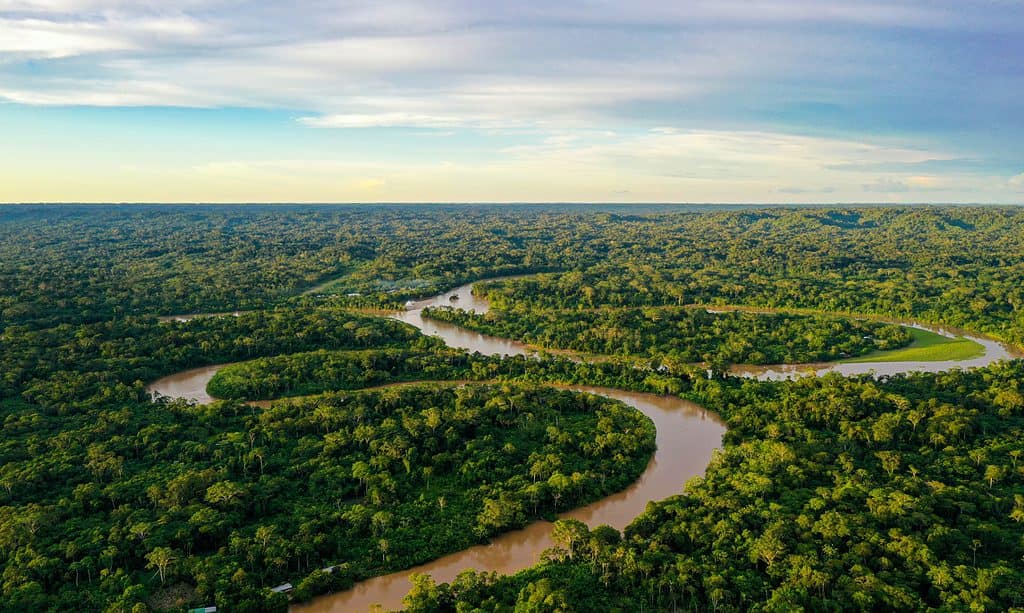
Rainforests are threatened by human demand for palm oil plantations.
©iStock.com/JarnoVerdonk
Recap: Palmetto Tree vs. Palm Tree
Although both are part of the same family, palmetto and palms are different trees.
The main difference is palm trees 80 feet in height that tower over a 30 feet tall palmetto, but other differences are clear. Palmetto foliage is wide and tough with serration, whereas feather-shaped palm leaves are thin. Palmetto’s red berries contrast with palm tree dates and coconuts.
Both like tropical, humid conditions, but palmetto is cold hardier. It’ll survive a fire, but palm trees can survive a hurricane! Both are valuable in terms of their foliage and fruit and oils.
Thank you for reading! Have some feedback for us? Contact the AZ Animals editorial team.

